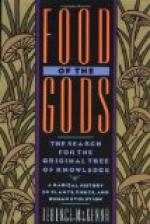In his “Treatise on Food and Dietetics,” Dr. Pavy remarks that:
“Containing, as pure cocoa does, twice as much nitrogenous matter, and twenty-five times as much fatty matter as wheaten flour, with a notable quantity of starch, and an agreeable aroma to tempt the palate, it cannot be otherwise than a valuable alimentary material. It has been compared in this respect to milk. It conveniently furnishes a large amount of agreeable nourishment in a small bulk, and, taken with bread, will suffice, in the absence of any other food, to furnish a good repast.”
Indeed, the value of cocoa as food for ordinary mortals as well as for mythical beings cannot be better summed up than in the words of Professor Lankester, Superintendent of the Food Collections at South Kensington, who declares:
“It can hardly be regarded as a substitute for tea and coffee; it is, in fact, a substitute for all other kinds of food, and when taken with some form of bread, little or nothing else need be added at a meal. The same may be said of chocolate.”
FOOTNOTES:
[1] According to Drs. Playfair and Lankester:
Tea contains 3 per cent. theine. Coffee " 1 3/4 " caffeine. Cocoa " 2 " theobromine.
Probably the proportion of caffeine in coffee would be more correctly stated as 1 1/4 per cent. Theine and caffeine are identical, but theobromine (C_{7}H_{8}N_{4}O_{2}) differs from both in the greater proportion of nitrogen which it contains.
[2] Dr. Johnson’s analysis:
Dried milk 35 \ Cocoa essence 34 3/4 \ Flesh formers in Cocoa-nibs 23 / each hundred parts. Best French chocolates 11 /
[3] Mr. O.L. Symonds, “Commercial Products of the Vegetable Kingdom.”
[4] The Cacao theobroma. There are several other varieties of cacao, but none of them produce the famous food.
[5] The Cocos nucifera, or “nut-bearing coco.”
[6] Erythroxylon coca.
[7] Or, as otherwise written, cacava quahuitl.
[8] 10 George III., c. 10.
[9] To make cocoa in perfection, for three breakfast-cups: in a quart jug (with rounded bottom and narrower neck by preference) mix 1 1/2 dessert spoonfuls (3/4 oz.) of Cocoa Essence with equal bulk of powdered white sugar, and stir to a thin paste with a little boiling water. Mix in an enamelled saucepan one breakfast-cup of milk with two cups of water (cups to be about 3/4 full), and boil with care. When on the boil, pour this over the contents of the jug, and whisk vigorously for a few seconds (see illustration, p. 1). Serve to table without delay. To make a richer drink, use equal parts of milk and water. To ensure the beverage being served as hot as possible, it is desirable to warm the jug before the cocoa is put into it. The effect of this method of preparation is to impart to the cocoa a more mellow taste, and to produce a deep froth on the surface, giving it a most appetizing appearance. The thorough mixing to which the cocoa is subjected also materially lessens the amount of sediment in the bottom of the cup.




